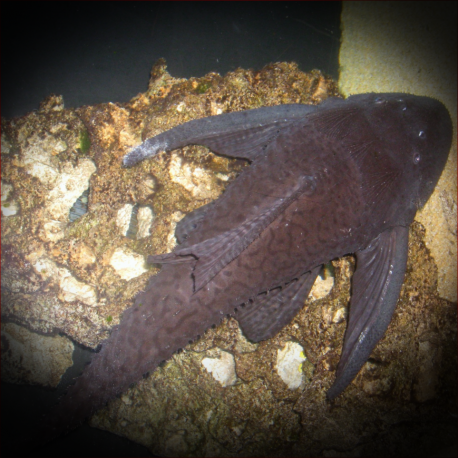More info
Datasheet
| Minimum Tank Size | 12000 litres / 3170.06 US gallons |
| Maximum Size | 100.0cm / 39.37inches |
| Temperature | 23°C / 73.40°F - 30°C / 86.00°F |
| Hardness | 2.02dgH / 36ppm - 12.05dgH / 215ppm |
| pH | 6.0-7.5 |
General Description
The Acanthicus Hystrix, commonly known as the Lyre Tail Plec or L155, is characterized by its striking spotted patterning, which fades as it matures. This species belongs to the Loricariidae family and can grow up to 100.0cm in size. Known for its unsuitability as a common aquarium subject, it is vital to provide proper care considering its territorial and aggressive nature as it matures.
Aquarium Setup
To accommodate the Acanthicus Hystrix in a home aquarium, it is suggested to provide dim lighting and refuge options such as driftwood, large rocks, or plastic piping. While juveniles may thrive in planted tanks, adults are likely to disturb or consume the vegetation. With a minimum tank size of 12000 liters, a robust filtration system, frequent water changes, and high oxygen levels are essential for this species' well-being.
Behaviour
Juvenile Acanthicus Hystrix individuals are generally peaceful, but as they mature, they become territorial and aggressive. It is recommended to keep adults singly in the absence of other substrate-dwellers. Compatible tankmates include large and pelagic fish from genera like Cichla, Osteoglossum, Brycon, and Acestrorhynchus.
Feeding and Diet
As a generalised detrivore, the Lyre Tail Plec requires a varied diet consisting of dried, frozen, and live foods such as sinking tablets, fruits, vegetables, bloodworms, and various meaty offerings. Malnourishment can hinder their growth, so adequate meal sizes and feeding frequency are crucial. Checking for sunken bellies and eyes can help identify signs of malnourishment in loricariid catfish.
Reproduction & Dimorphism
Reproduction of Acanthicus Hystrix has not been documented in captivity. These fish are believed to be cave spawners, with males guarding and tending to the eggs. Sexual dimorphism is visible in males through the development of extensive odontal growth on pectoral rays, cheeks, and body. Examination of the genital papilla can also help differentiate between males and females.
Habitat and Distribution
Acanthicus Hystrix predominantly inhabits slower-moving sections of rivers and tributaries, often found near human settlements. While the exact type locality is unspecified, these fish are commonly distributed across the Amazon region in Brazil and Peru, with a few documented records in the Río Orinoco drainage in Venezuela.

